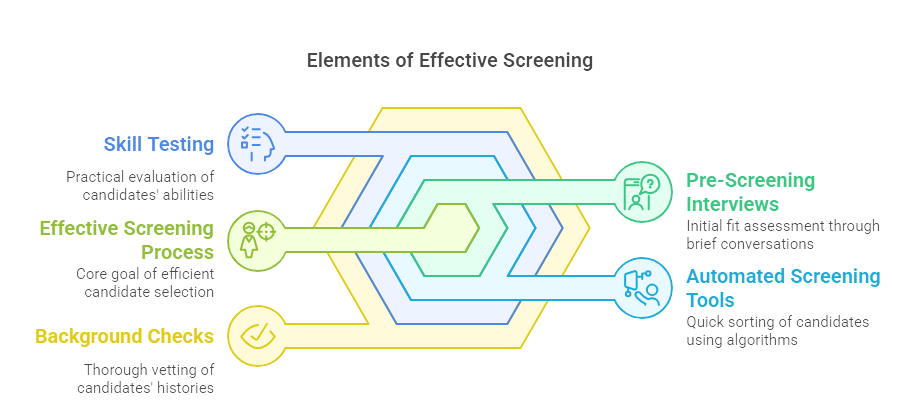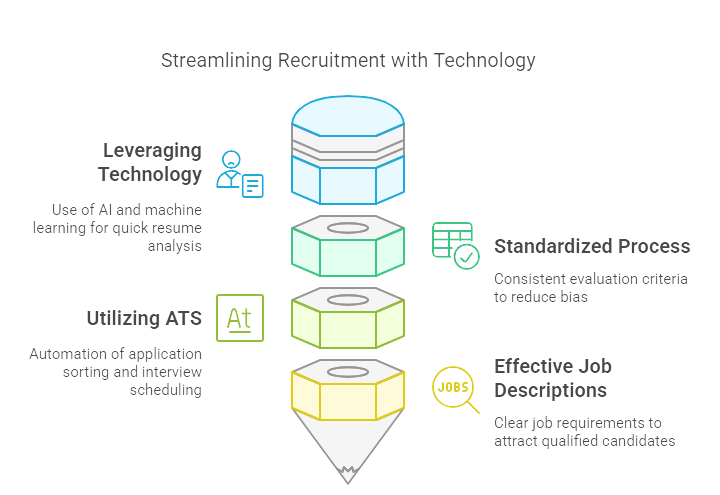In today's fast-paced job market, the ability to quickly and efficiently screen candidates is crucial. Not only does it help fill positions faster, but it also ensures that the best talent is not lost to competitors. This guide will explore various strategies and best practices for improving speed and efficiency in screening processes, tailored specifically for business owners, HR professionals, recruiters, and job seekers.
Key Takeaways
- Speed and efficiency in the screening process are crucial for gaining a competitive edge in the job market and ensuring a positive candidate experience.
- Effective screening involves core elements such as pre-screening interviews, automated screening tools, skill testing, and efficient background checks.
- Techniques like leveraging AI, creating standardized processes, using ATS, and crafting detailed job descriptions can streamline the screening process.
- Efficient verification practices, including pre-employment tests, automated reference checks, and clear communication, are essential for a speedy hiring workflow.
- For job seekers, being prepared, maintaining a professional online presence, and being ready for skill tests are vital in a fast-paced screening environment.
Introduction
In the modern job market, speed and efficiency are not just luxuries—they're necessities. Whether you're a business owner, HR professional, recruiter, or job seeker, mastering the art of efficient screening can make or break your hiring strategy. This article will delve into key aspects of improving your screening process, ranging from leveraging technology to optimizing pre-employment tests.
Improving your screening process isn't just about saving time. For employers, it means filling positions with top talent before competitors can snatch them away. For candidates, a faster process translates to a more positive experience. The end goal? A win-win situation where businesses secure qualified employees quickly and job seekers land roles that fit their skills and aspirations.

The Importance of Speed and Efficiency in Screening
In the competitive world of recruitment, speed is your not-so-secret weapon. A quicker screening process means you're more likely to snag top talent before the competition does. It's not just about filling positions faster—though that certainly matters—it's about securing the best candidates before they go elsewhere. The quicker you identify and process talent, the better your chance of hiring A-players who might otherwise be snapped up by a competitor with a faster pipeline.
But there's more to it. Consider the financial angle. Every day a position remains unfilled is a day of lost productivity and potentially higher costs. Cutting down the time-to-hire means reducing these financial drains. Quicker decisions can lead to better operational efficiency and, ultimately, a more robust bottom line.
Don't forget the candidate's experience either. A streamlined process makes a difference here too. No one enjoys being stuck in a drawn-out, unclear screening process. A fast, transparent, and efficient approach leaves a positive impression, reflecting well on your company and making you more attractive to high-quality candidates. After all, the best talent has options, and they'd rather sign on with an organization that demonstrates respect for their time.
EXPERT INSIGHT: Knowing what fair hiring entails will help your hiring process be both compliant and inclusive. Whether you're an HR representative, business manager, or hiring manager, knowing how to handle legal compliance and reduce bias will impact your hiring process significantly. To help in your endeavor, we've compiled a series of frequently asked questions on the fundamentals of fair hiring—ranging from equal opportunity compliance and background checks through reducing bias and preventing legal pitfalls. Not only will these answers make your process work, but they will also render it respectful and inclusive for everyone applying. - Charm Paz, CHRP
Elements of Effective Screening
Improving the speed and efficiency of your screening process starts with understanding its core components. Let’s break down the elements that make a screening process truly effective.
Pre-Screening Interviews
Not every candidate will be the right fit for every job, and that's okay. Pre-screening interviews serve as a preliminary filtering step to sieve out those who may not meet the essential criteria. Conducting a brief 10-15 minute conversation can quickly establish whether the candidate possesses the skills, experience, and cultural fit needed for the role. This saves both parties valuable time and prevents unnecessary steps further down the hiring pipeline.
Automated Screening Tools
Automation is your best friend when aiming for both speed and accuracy. Automated screening tools can efficiently handle the initial phases of the screening process. From parsing resumes for key qualifications to assessing initial application forms, these tools ensure that only candidates meeting specific criteria are moved forward. These systems utilize algorithms to sort applicants based on job-specific requirements, dramatically cutting down on manual review time. For more insights, refer to How Long Does a Background Check Take?.
Skill Testing
Skill assessments are a reliable way to gauge a candidate's capabilities without extended interviews. These can range from coding tests for tech roles to problem-solving exercises for administrative positions. By integrating skill testing early in the process, you can quickly identify candidates who not only claim to have certain skills but can demonstrate them effectively. Employing standardized tests also ensures a fair evaluation, providing tangible data to support your hiring decisions.
Background Checks
Background checks are indispensable, but they often come with their own set of delays and complications. Efficient background checks involve streamlining this process with reliable vendors and leveraging technology wherever possible. Prioritize checks that are most critical for the role—such as criminal history, employment verification, and education qualifications—to ensure thorough vetting without unnecessary holdups. For more in-depth information, you can refer to guidelines from the Department of Labor and the FTC.
By focusing on these core elements—pre-screening interviews, automated screening tools, skill testing, and efficient background checks—you'll create a more streamlined and effective screening process. This not only saves time but also ensures you're selecting the best candidates efficiently and equitably.

Techniques for Fast Screening
Leveraging Technology
Incorporating advanced technology like AI and machine learning into your screening process is no longer optional – it's essential. Automated systems can sift through resumes, pinpointing keywords and qualifications that match the job description. This reduces the initial screening time from hours to mere minutes. AI-driven tools can even score and rank candidates, offering an objective assessment that helps streamline decision-making. Utilizing chatbots to handle initial queries can also free up HR personnel to focus on more complex matters.
Creating a Standardized Process
Having a standardized screening process is akin to having a well-oiled machine. It ensures every candidate is evaluated on the same criteria, reducing bias and speeding up the process. Create templates for common steps like interview questions, evaluation forms, and communication emails. A uniform approach minimizes the time spent tailoring the process for each candidate and allows team members to easily step in and assist without a steep learning curve.
Utilizing ATS (Applicant Tracking Systems)
Applicant Tracking Systems (ATS) are a recruiter’s best friend when it comes to speed and efficiency. These systems automate the collection, sorting, and reviewing of candidate information. An effective ATS can filter applications based on predetermined criteria, flag high-potential candidates for further review, and even schedule interviews. The integration of ATS with other HR technologies like calendar apps and email can further streamline the process, making it seamless from end to end.
Effective Job Descriptions
A well-crafted job description does more than just list qualifications and responsibilities – it pre-screens candidates for you. Clear, detailed job descriptions help attract the right candidates, ensuring those who apply are genuinely qualified for the position. Focus on listing not only the job requirements but also specific skills and attributes you desire. Clarity up front leads to a higher quality applicant pool, reducing the time spent weeding out unqualified candidates during the screening process.
These techniques combined can drastically cut down the time and effort involved in screening, allowing your organization to keep pace in a competitive job market.

Best Practices for Efficient Verification
When it comes to verification, efficiency is key. Streamlining this process not only speeds up hiring but also ensures that the best candidates aren't left hanging. Here’s how you can boost the efficiency of your verification phase without compromising on thoroughness.
Pre-Employment Tests
Pre-employment tests are crucial for verifying candidate qualifications quickly. These tests can range from technical assessments to cognitive and personality tests. Automating test delivery and scoring can significantly cut down the time spent manually evaluating each candidate. Many platforms offer standardized tests aligned with industry norms, ensuring you get reliable and valid results swiftly.
Reference Checks
Conducting reference checks can be time-consuming, but it's a necessary step. Automation can help here too. Utilizing automated reference-checking tools allows candidates to send out reference requests digitally, while you receive consolidated, easy-to-read reports. This reduces the back-and-forth communication traditionally seen in manual reference checks.
Clear Communication
Maintaining clear and timely communication with candidates is vital to keep the process moving smoothly. Setting expectations early about the verification steps helps avoid misunderstandings and keeps candidates engaged. Whether it’s informing them about the timeline for reference checks or the pre-employment tests, prompt communication fosters a seamless verification process.
Efficient verification processes contribute significantly to a streamlined hiring workflow. By leveraging pre-employment tests, automated reference checks, and maintaining clear communication, you not only speed up the process but also ensure that candidate qualifications are verified comprehensively and quickly.
Common Pitfalls and How to Avoid Them
Overcomplicated Procedures
One of the main hurdles in the screening process is overcomplication. Implementing excessive steps, unnecessary assessments, or redundant interviews can bog down the process. It’s vital to streamline—to break down the necessary steps and eliminate the superfluous ones. Keep it simple. This way, you maintain momentum without compromising the quality of your candidates.
Ignoring Automation
In today's tech-driven landscape, not leveraging automation tools is a missed opportunity. Manual processes are not only slower but also more prone to human error. Tools like AI-driven applicant tracking systems (ATS) and automated pre-screening software can handle repetitive tasks efficiently, allowing HR professionals to focus more on candidate engagement and less on paperwork. Embrace these technologies to save time and resources.
Delays in Background Checks
Background checks can be a major bottleneck if not managed properly. Delays often occur due to reliance on outdated methods or lack of clear communication with third-party verification services. To speed this up, choose reliable providers, stay in constant communication, and use integrated systems that update you in real time. Quick, thorough background checks make for a smoother and faster screening process.
By recognizing and addressing these common pitfalls, the screening process can be significantly improved, leading to faster hiring, reduced costs, and a better candidate experience.

Improving the Candidate Experience
Improving the candidate experience is not just a kindness; it’s an efficiency booster. A positive screening process keeps top talent engaged, minimizes drop-offs, and enhances your company’s reputation. Here’s how to master it:
Transparency: Being open about your process timeline and expectations helps manage candidates' anxieties and sets clear expectations. Communicate each step of the process, what it involves, and the approximate time frame. This kind of transparency reduces uncertainty, keeps candidates engaged, and demonstrates respect for their time and efforts.
Feedback: Provide timely and constructive feedback. Whether a candidate moves to the next phase or not, feedback can be invaluable. Make it concise, specific, and actionable. Quick feedback keeps applicants engaged and reduces the time they spend wondering about their status, which, in turn, helps maintain momentum in your screening process.
User-Friendly Application Process: The easier the application process, the better. Avoid long, cumbersome forms that frustrate candidates. Instead, aim for straightforward, intuitive applications that require minimal effort to complete. Mobile optimization is key, as many candidates prefer to apply via their smartphones. The less friction they encounter, the quicker you can get to evaluate their qualifications.
Mastering these elements creates a streamlined, candidate-friendly process that not only attracts better applicants but also makes the screening process faster and more efficient for everyone involved.
Tips for Job Seekers
Preparing for Fast Screening
Job seekers, it's essential to be ready for a rapid screening process. This means having a current, concise resume that highlights your key achievements and skills. Keep your documents organized and easily accessible, including your resume, cover letter, and any certifications. Make sure you have professional references lined up, and inform them that they might be contacted soon. Respond promptly to any communication from potential employers to keep the process moving smoothly.
Professional Online Presence
In today's digital age, your online presence can significantly impact the speed and success of your job search. Ensure your LinkedIn profile is up-to-date, reflecting your latest experiences and skills. A polished and professional online presence can expedite background checks and verifications, allowing potential employers to easily confirm your qualifications and suitability for the role. Review your social media profiles and clean up any content that could be deemed unprofessional or inappropriate.
Preparation for Skill Tests
Many companies use pre-employment tests to streamline their screening process. Familiarize yourself with the types of assessments commonly used in your industry. There are many online resources and practice tests available that can help you prepare. Brush up on relevant skills and be ready to demonstrate your abilities under timed conditions. Preparing in advance will not only boost your confidence but also your chances of passing these assessments with flying colors.
By taking these steps, you'll position yourself as a proactive, prepared candidate—qualities that can help you stand out in a fast-paced screening environment.
Conclusion
In summary, enhancing the speed and efficiency of your candidate screening process offers substantial benefits, including competitive advantage, cost-efficiency, and a better candidate experience. We've explored the importance of quick and efficient screening, essential elements like pre-screening interviews and automated tools, and outlined proven techniques such as leveraging technology and standardized processes.
Fast and efficient verification practices—like pre-employment tests and effective communication—further streamline hiring. Avoiding common pitfalls such as overcomplicated procedures and delays in background checks ensures a swifter process. Enhancing the candidate experience through transparency and user-friendliness also pays dividends.
For job seekers, being prepared for fast screening, maintaining a professional online presence, and preparing for skill tests can make a significant difference.
Ultimately, a well-optimized screening process creates a win-win situation for both employers and candidates. Businesses that implement these strategies will not only fill positions more quickly but also attract and retain top talent.

